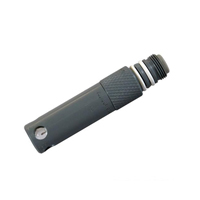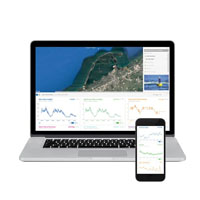To some, it may seem obvious why measuring water quality is a critical task. For others, the question of why measure water quality is earnestly posed. However, once you consider all of the facts, it’s obvious that there are many reasons to measure water quality, most of them of high importance to multiple people.
In this post, we’ll cover some of the major reasons why measuring water quality matters, and how a failure in any one of these areas can cause serious problems.
Water Quality Basics
That water that comes out of the tap, or flows in the river near your home, or into the pipes from the well or reservoir—how can you be sure it’s clean? Is it safe to drink, or for other uses? Muddy, brown looking water might be safe for your plants, but not your children—but looks can be deceiving when it comes to water quality, too.
When we consider why we measure water quality, it helps to consider the concept of water quality itself as to how suitable a particular sample of water is for a specific use. You make that determination by measuring relevant chemical, physical, and biological characteristics, including alkalinity; biological oxygen demand; color; dissolved oxygen levels; conductivity; hardness; nitrogen, phosphorus, and other nutrients; pH; and turbidity.
Alkalinity, pH, Acid Rain, and Mining
Alkalinity and pH are both key water quality parameters. Everything that lives in and near a lake, stream, or other waterway has evolved slowly, over time, to require a certain set of chemical requirements. Before human industry, there was nothing changing the aquatic environment quickly in the form of acid rain or chemical contamination—but that is no longer the case.
Today, organisms are subject to much more wildly fluctuating conditions and have far less time to adapt as circumstances change. As chemicals enter waterways or acid rain falls, the aquatic characteristics and pH of that water changes, threatening the health of the aquatic flora and fauna in the water. Quick changes in pH are unhealthy for most organisms, as is a lack of stability when it comes to alkalinity and pH.
Waters with high alkalinity maintain a pH that is mostly constant with greater ease. Water’s pH, on the other hand, determines how biologically available, and soluble, various heavy metals and chemical constituents are. For example, water with a lower pH is better able to dissolve toxic metals such as cadmium, copper, and lead, so it tends to be more dangerous. Water’s pH also affects how well biological organisms can make use of nutrients such as carbon, nitrogen, and phosphorus in it, changing both quantity and form of various constituents.
So, one reason why we must measure water quality has to do with alkalinity and pH, and how modern human industrial concerns made acid rain, mining contamination, and other related problems making these parameters more relevant than ever. Most of Earth’s ecosystems can tolerate some amount of acid rain, but only to a point. Naturally occurring bases in soils tend to counteract some of the acidity from acid rain. However, in some places, such as the southeastern United States and some parts of the northwest and the Rocky Mountains, limestone occurs less frequently in the soil as a natural matter, so acid rain hurts the environment.
Acid rain can also make it harder for some animals, such as frogs and fish, to adapt to and reproduce within their natural environments. This is in part because acid rain damages the flora in the ecosystems in question.
The water in mine drainage also carries hazards when it comes to alkalinity and pH, metal-rich thanks to chemical reactions and rocks containing sulfur and water. Iron and sulfuric acid result from the reactions and cause unnaturally bright colors to show in the water, signaling the sinking of dissolved heavy metals such as lead, copper, and mercury into surface water or groundwater with flashes of orange, red, and yellow sediment.
Acid mine drainage proceeds can worsen, depending on the rate and degree of bacterial action. Either way, mine drainage is linked to drinking water contamination, corrosion of built and natural infrastructure, and disruption of aquatic life cycles. Correcting these kinds of problems can run into the billions in some areas—when it can be fixed at all.
Urban Water Quality Problems
Part and parcel of modern water quality issues are urban water quality problems. These are issues that mandate that we measure water quality, simply because urban living crowds too many humans together in small spaces. Some of these include traces of pharmaceuticals in water, contamination from sewage and stormwater overflows, and changes to the aquifer itself caused by shifts in land-use.
A team from the US Geological Survey (USGS) has discovered that facilities that manufacture pharmaceuticals sometimes release a significant amount of pharmaceuticals into the environment. Other researchers have found that effluents from wastewater treatment plants (WWTPs) in urban areas and in locations that receive pharmaceutical manufacturing facilities’ (PMFs’) discharge have much higher concentrations of pharmaceuticals than do effluents in rural areas.
Pharmaceuticals in water have many sources, not just companies that manufacture medicine. In urban areas, more people take more medications, and we excrete them into the wastewater system. In other areas, livestock animals are responsible for excreting drugs into water. In any event, most wastewater treatment plants do not have the equipment to remove pharmaceuticals from water.
Sewer and stormwater overflows are another water quality problem in a time of urban living. Sewers and storm drains are built in many different ways, and many of them are very old and inadequate to the task of larger and larger populations of people. Blocked lines, leaking pipes, insufficient carrying capacity in pipes and sewers, and pumping stations power outages can cause sewage to overflow into nearby waterways. This is an especially serious problem in cities where combined sewers carry both stormwater runoff and raw sewage—and a serious storm can cause raw sewage to back up into businesses and homes and other toxic runoff to drain into waterways.
Finally, changes to land use mean that people build more, drill wells to draw more water from the aquifer, create sewage or septic systems, and remove vegetation. This, in turn, causes erosion and storm runoff as water rolls off hills without vegetation, and more sediment in waterways. Floods can happen and new patterns in drainage emerge.
Eventually, as cities continue to grow, fewer water-permeable surfaces are available for water to return to the aquifer, and water that does soak through is contaminated by oil and gas. Reservoirs and dams may be constructed to control water supplies, further changing the landscape. Wastewater is probably released into local rivers and streams. It eventually becomes difficult to recharge the water table.
Why Measure Water Quality?
There are so many reasons to keep an eye on water quality. Any one of the main water quality parameters is linked to important signs of environmental health. For more on why we measure water quality and how we do it, refer to our in-depth water quality guide.
Top image: Wayne National Forest [CC BY 2.0 (https://creativecommons.org/licenses/by/2.0)]
Equipment
The YSI 1001 pH Sensor provides long life, good response time, and accurate readings in most environmental waters, including freshwater of low ionic strength.
WQData LIVE is a web-based project management service that allows users 24/7 instant access to data collected from remote telemetry systems.





0 comments